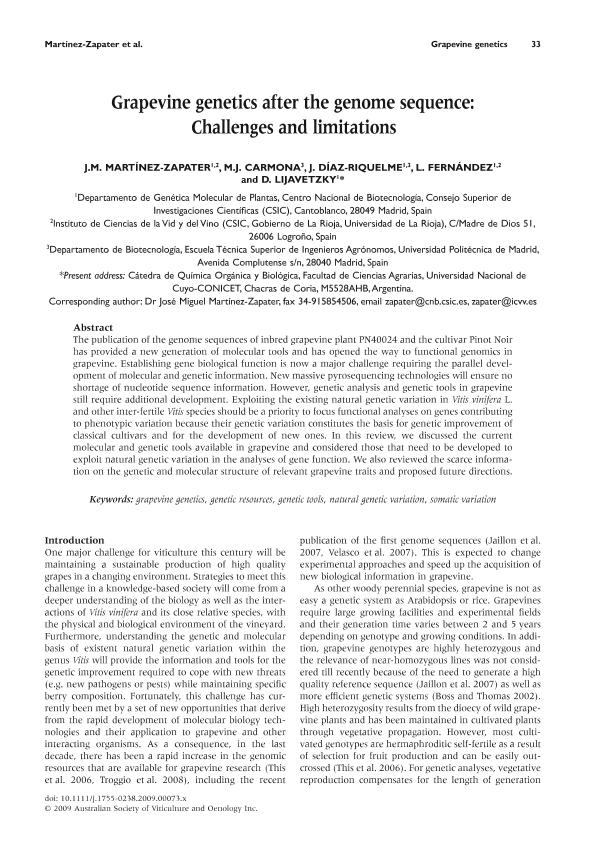Mostrar el registro sencillo del ítem
dc.contributor.author
Martínez Zapater, José M.

dc.contributor.author
Carmona, M. J.
dc.contributor.author
Diaz Riquelme, J.
dc.contributor.author
Fernández, L.
dc.contributor.author
Lijavetzky, Diego Claudio

dc.date.available
2020-06-08T15:45:31Z
dc.date.issued
2010-01
dc.identifier.citation
Martínez Zapater, José M.; Carmona, M. J.; Diaz Riquelme, J.; Fernández, L.; Lijavetzky, Diego Claudio; Grapevine genetics after the genome sequence: Challenges and limitations; Wiley Blackwell Publishing, Inc; Australian Journal Of Grape And Wine Research; 16; 1; 1-2010; 33-46
dc.identifier.issn
1322-7130
dc.identifier.uri
http://hdl.handle.net/11336/106854
dc.description.abstract
The publication of the genome sequences of inbred grapevine plant PN40024 and the cultivar Pinot Noir has provided a new generation of molecular tools and has opened the way to functional genomics in grapevine. Establishing gene biological function is now a major challenge requiring the parallel development of molecular and genetic information. New massive pyrosequencing technologies will ensure no shortage of nucleotide sequence information. However, genetic analysis and genetic tools in grapevine still require additional development. Exploiting the existing natural genetic variation in Vitis vinifera L. and other inter-fertile Vitis species should be a priority to focus functional analyses on genes contributing to phenotypic variation because their genetic variation constitutes the basis for genetic improvement of classical cultivars and for the development of new ones. In this review, we discussed the current molecular and genetic tools available in grapevine and considered those that need to be developed to exploit natural genetic variation in the analyses of gene function. We also reviewed the scarce information on the genetic and molecular structure of relevant grapevine traits and proposed future directions.
dc.format
application/pdf
dc.language.iso
eng
dc.publisher
Wiley Blackwell Publishing, Inc

dc.rights
info:eu-repo/semantics/openAccess
dc.rights.uri
https://creativecommons.org/licenses/by-nc-sa/2.5/ar/
dc.subject
Grapevine genetics
dc.subject
Genetic resources
dc.subject
Genetic tools
dc.subject
Natural genetic variation
dc.subject.classification
Genética y Herencia

dc.subject.classification
Ciencias Biológicas

dc.subject.classification
CIENCIAS NATURALES Y EXACTAS

dc.title
Grapevine genetics after the genome sequence: Challenges and limitations
dc.type
info:eu-repo/semantics/article
dc.type
info:ar-repo/semantics/artículo
dc.type
info:eu-repo/semantics/publishedVersion
dc.date.updated
2020-05-11T16:48:19Z
dc.journal.volume
16
dc.journal.number
1
dc.journal.pagination
33-46
dc.journal.pais
Reino Unido

dc.journal.ciudad
Londres
dc.description.fil
Fil: Martínez Zapater, José M.. Consejo Superior de Investigaciones Cientificas. Center For Research In Agricultural Genomics; España
dc.description.fil
Fil: Carmona, M. J.. Universidad Politécnica de Madrid; España
dc.description.fil
Fil: Diaz Riquelme, J.. Universidad Politécnica de Madrid; España
dc.description.fil
Fil: Fernández, L.. Consejo Superior de Investigaciones Cientificas. Center For Research In Agricultural Genomics; España
dc.description.fil
Fil: Lijavetzky, Diego Claudio. Consejo Superior de Investigaciones Cientificas. Center For Research In Agricultural Genomics; España. Consejo Nacional de Investigaciones Científicas y Técnicas. Centro Científico Tecnológico Conicet - Mendoza. Instituto de Biología Agrícola de Mendoza. Universidad Nacional de Cuyo. Facultad de Ciencias Agrarias. Instituto de Biología Agrícola de Mendoza; Argentina
dc.journal.title
Australian Journal Of Grape And Wine Research

dc.relation.alternativeid
info:eu-repo/semantics/altIdentifier/doi/http://dx.doi.org/10.1111/j.1755-0238.2009.00073.x
dc.relation.alternativeid
info:eu-repo/semantics/altIdentifier/url/https://onlinelibrary.wiley.com/doi/full/10.1111/j.1755-0238.2009.00073.x
Archivos asociados
